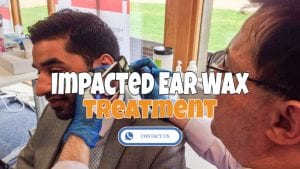Why Does Cerumen (Ear Wax) Get Infected When It’s Impacted
This article should answer all of your questions concerning ear wax, often known as cerumen. You should educate yourself on what cerumen is, where it is located, and the difficulties it might create. Hearing Impairment Bob is a senior citizen who wears a hearing aid in his right ear. He’s just found that he’s having difficulty hearing out of both ears. He replaced the battery in his hearing aid to ensure correct operation, but this did not assist.
Additionally, he has experienced pain in his left ear and has experienced dizziness on occasion. Bob is concerned that his hearing may be deteriorating and schedules an appointment with his doctor. The doctor examines Bob’s ears and discovers an accumulation of cerumen.
Bob is unsure what this means—is he to be concerned? Cerumen – What Is It? The medical term for ear wax is cerumen. The body produces it in the outer ear canal to protect and clean the ear. The yellowish waxy substance is made up of lubricants and dried bodily tissue.
What Purpose Does Cerumen Serve?
The ear canal is the passageway that connects the eardrum to the external ear. Small bones behind the eardrum aid in hearing by translating vibrations to sounds. Cerumen is a substance found in the ear canal, just before of the eardrum.
Cerumen can act as a barrier against germs, fungi, insects, and water. The ear cleans itself by shedding dead tissue and lubricating the canal, allowing vibrations to pass freely through and be converted to sound. The cerumen functions as a barrier for germs and fungi, trapping them in the sticky wax. These potentially dangerous compounds then exit the body rather than continuing to penetrate the ear canal and causing damage.
What Happens to Cerumen When It Is Impacted?
The cerumen in the ear is entirely natural. Occasionally, however, it can accumulate and become a problem. When the body does not effectively eliminate the wax, it becomes lodged in the ear canal. Common symptoms of impacted cerumen include earache, discomfort, ringing, and dizziness. If the cerumen is not removed and accumulates, it might result in further hearing loss.
The wax accumulates in front of the eardrum and has a significant effect on the sound that enters the ear. Vibrations are unable to travel through the eardrum, resulting in difficulty hearing. Individuals over the age of 65 and those who wear hearing aids are more likely to have impacted cerumen. Individuals who use cotton-tipped swabs are also at risk since they are pushing wax further into the ear. How is cerumen removed from the body? Our bodies are programmed in such a way that shifting the jaw aids in the removal of cerumen from the ear. Occasionally, the wax will accumulate or be visible on the outer ear, but this is readily removed. Cerumen that has been impacted can cause hearing loss, which is why it is critical to have it removed properly.
Never use cotton-tipped swabs to remove cerumen. Not only do they force wax deeper into the canal, but they can also cause damage to the eardrum if pushed too far into the canal. Often, doctors will prescribe an over-the-counter wax softener to safely remove ear wax. A few drops are inserted into the ear, and the cerumen will naturally release and discharge. This can also be done at a doctor’s office, particularly if the wax is obstructing the view of the eardrum during an examination. If over-the-counter remedies do not effectively remove the cerumen, irrigation of the ear canal is required. This technique is performed in a doctor’s office and includes instilling very warm water into the ear. The water then bounces off the eardrum and pours out the other ear. As the water exits the ear canal, the power of the water loosens the impacted cerumen and drains it.
Additionally, a doctor may remove ear wax using an ear curette or scoop. This should never be performed by anybody other than a skilled physician, as the curette can cause damage to the eardrum if placed too far into the canal. Points to remember Cerumen is another term for ear wax. While this is inconvenient, it is not hazardous. Cerumen is produced by the ear canal to defend it against foreign substances such as germs, fungus, and insects. Cerumen is normally discharged by the ear’s natural movements, but it can build up occasionally. Impaction is a build-up of cerumen that, while not serious, can cause hearing issues. If there is an excessive amount of wax in the canal, the vibrations needed to produce sound becomes dull, making hearing difficult. Additionally, cerumen impaction might result in pain, a full sensation in the ear, and dizziness. Wax can be removed using solutions that soften ear wax; they are available over the counter and should be used as directed by your physician. Cotton tipped swabs should never be used to remove cerumen because they drive it deeper into the ear and risk damaging the eardrum.
Why You Shouldn’t Clean Your Ears, Doctors Say
Earwax is a natural substance produced by the human body to clean, protect, and ‘oil’ the ears against dirt, dust, and other tiny particles that adhere to the earwax and prevent them from entering the ear further, study states.
“Moisture and cerumen (ear wax) are the primary causes of hearing aid failure, and Ear Technology’s solutions address these concerns and can reduce hearing aid failures by 70%,” says business founder and president Daniel Schumaier. Corporation for Ear Technology Otitic cerumen and inspissated pus were collected from the external ear near the external acoustic meatus using sterile swabs moistened with sterile saline solution, whereas aural discharges were collected using a dry sterile swab for cytological examination, bacteriological and mycological culture in order to identify the etiological agents.
The ear canal produces cerumen as a natural and protective process. Cerumen, on the other hand, should be removed if it produces symptoms (e.g., hearing loss, itching, discomfort, or tinnitus) or obstructs evaluation of the external auditory canal, tympanic membrane, or audiovestibular system. Cerumen should also be withdrawn in patients who are unable to express their symptoms, such as individuals with dementia or developmental delay, nonverbal patients exhibiting behavioural abnormalities, and young toddlers with fever, speech delay, or parental worries. Patients with coagulopathies, liver failure, thrombocytopenia, or haemophilia, as well as those on antiplatelet or anticoagulant medicines, should be counselled of the increased risk of external auditory canal bleeding when cerumen is removed.
Cerumenolytic medicines, irrigation with or without cerumenolytic preparation, and manual removal are all effective treatment methods. For some individuals, home irrigation using a bulb syringe may be acceptable. Avoid cotton swabs, ear candling, and olive oil drops or sprays. If numerous attempts at removing the affected cerumen are unsuccessful, physicians should send the patient to an otolaryngologist. Persistent symptoms despite clearance of the impaction might also trigger further assessment for a different diagnosis.
The wax that develops in the canal naturally migrates to the canal’s outside and eventually falls out. At times, the ear canal may retain an excessive amount of wax. This might result in a blockage and hearing loss. Home treatment instructions are included below. Care at home If your physician has instructed you to remove a wax blockage on your own, follow these steps: Unless a prescription has been written, you may use an over-the-counter medication designed to remove earwax. These are composed of carbamide peroxide. Assume a supine position with the occluded ear pointing upward. Wait a few minutes after applying one dropper full of medication. Take hold of the outer ear and jiggle it to assist the solution in entering the canal. Lean over a sink or basin, looking downward with the blocked ear. Rinse the ear several times with a bulb syringe filled with warm (not hot or cold) water.
Apply only a little pressure. If you’re having difficulty emptying water from your ear canal, place a few drops of rubbing alcohol (isopropyl alcohol) in the ear canal. This will assist in removing any leftover water. Rep this technique once a day for a maximum of three days, or until your hearing returns to normal. Use this therapy for no more than three consecutive days. Don’ts Avoid rinsing the ear with cold water. This will cause you to feel dizzy. If you have an ear infection, do not attempt this operation. This operation should not be performed if you have a ruptured eardrum. Avoid “cleaning” the ear canal with cotton swabs, matches, hairpins, keys, or other items. This might result in an ear canal infection or a ruptured eardrum.
Cotton swabs, due to their size and shape, might push earwax further into the ear canal rather than removing it. Adequate follow-up care Consult your health care practitioner if your condition does not improve after three cleaning attempts, or as recommended. When to consult a physician Contact your health care provider immediately if any of the following occur: Ear discomfort becomes more severe Fever of 101 degrees Fahrenheit (38.3 degrees Celsius) or higher, or as instructed by your health care provider After three days of therapy, hearing does not return to normal. Drainage of fluid or bleeding from the ear canal Outer ear swelling, redness, or discomfort Whether it’s a headache, neck pain, or a stiff neck,
Brought To You By: Ear Wax Removal Hendon
Medical Disclaimer: The information on this site is for your information only and is not a substitute for professional medical advice.
The Article What Happens When Cerumen (Ear Wax) is Impacted? First Appeared ON
: https://gqcentral.co.uk


Comments are closed